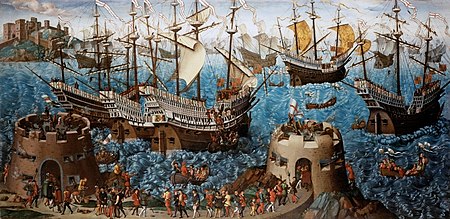Field of the Cloth of Gold
Held at Balinghem, between Ardres in France and Guînes in the English Pale of Calais, it was a very expensive display of wealth by both kings.The two monarchs would meet again in 1532 to arrange Francis's assistance in pressuring Pope Clement VII to pronounce Henry's first marriage as illegitimate.Under the guidance of English Cardinal Thomas Wolsey, these European states sought to outlaw war forever among Christian peoples.This territorial leftover from the Hundred Years' War caused some tensions between the English and French, as the latter preferred a location closer to the border, but topographical considerations proved the decisive factor.The 1518 Treaty of London, a non-aggression pact between major European powers to help resist the Ottoman expansion into southeastern Europe, had just been signed.The meeting was designed to show how magnificent each court was, and how this could be a basis for mutual respect and peace between states that were traditional enemies.The meeting place (now indicated by a commemorative plaque on the D231 road, Route de Marquise) was at the very edge of the English territory around Calais.The whole event was planned and executed by English Cardinal Thomas Wolsey, a charismatic, eloquent master diplomat who as a papal legate had immense power in the name of Pope Leo X at the time of the meeting.From 27 to 30 October 1396, Charles VI of France and Richard II of England had met at Ardres near Calais to treat for peace during the Hundred Years' War.The most elaborate arrangements were made for the accommodation of the two monarchs and their large retinues; and on Henry's part especially no efforts were spared to make a great impression in Europe with this meeting.One further aspect of King Henry's retinue was the presence of two royal monkeys covered in gold leaf; these were known to have been gifts from the Ottoman Sultan Selim I and brought much laughter and merriment from Francis I as contemporary Cardinal Wolsey recounts, "The French King was overcome with much curiosity playing with those little knaves that did all they could to steal and pester his advisers, yet he willed them to be present at every banquet".Chronicle descriptions make it clear the decorations, carved and painted had martial iconography; The foregate of the same palace or place with great and mighty masonry by sight was arched, with a Tower on every side of the same portered by great craft, and inbatteled was the gate and Tower, and in the fenesters, and windows, were images resembling men of warre redie to cast great stones: also the same gate or Tower was set with compassed images of ancient Princes, as Hercules, Alexander and other, by entrayled worke, richly limned with gold and Albyn colours, .... also the tower of the Gate as seemed was built by great masonry, ... for the sundrie countenances of every Image that their appeared, some shooting, some casting, some ready to strike, and firing of gonnes, which shewed very honourably.Galyon Hone was one of the stained-glass artists employed at the Field.Composer Jean Mouton was most likely in charge of the musical production by Francis I; the French royal chapel had one of the finest choirs in Europe, and contemporary accounts indicated that they "delighted their hearers.[10] Musical production on the English side was probably led by composer William Cornysh the Younger, master of the Royal Chapel for Henry VIII.[11] Some idea of the size of Henry's following may be gathered from the fact that in one month 2200 sheep and other viands in a similar proportion were consumed.After Cardinal Wolsey, with a splendid train, had visited the French king, the two monarchs met at the Val d'Or, a spot midway between the two places, on Thursday, 7 June Corpus Christi.A record of the list of participants survives in at least two places: in the Rutland Papers[3] and in the Letters and Papers, Foreign and Domestic, of King Henry VIII,[14] catalogued as Letters indented specifying, in accordance with the treaty of 12 March 1519, the number and rank of the lords, ladies and gentlemen to attend the King and Queen at the interview with Francis I.Councillors of the long robe; viz., the King's secretary, the vice-chancellor, the dean of the Chapel, and the almoner, each to have 12 servants, one a chaplain, and 8 horses.The lords of St. John, Burgevenny, Devonshire, Montague, Mounteagle, Cobham, Ferrers, Fitzwalter, Dudley, Dacres of the South, Darcy, Conyers, Audeley, Broke and Fitzwarren.



The Field of the Cloth of Gold (novel)Royal CollectionHampton CourtHenry VIIIFrancis IJean ClouetLouvreJoos van CleveFrenchsummit meetingHenry VIII of EnglandFrancis I of FranceBalinghemArdresFranceGuînesPale of CalaisPope Clement VIIfirst marriageThomas WolseyHundred Years' WarWolseyHabsburgHoly Roman EmpireCharles V, Holy Roman EmperorKingdom of EnglandTreaty of Londonnon-aggression pactOttoman expansionNetherlandsCalaisRenaissancepapal legatePope Leo XThomas MoreAnne BoleynmothersisterCharles VI of FranceRichard II of EnglandDover CastleHampton Court Palacejoustingcloth of goldretinuesSelim IGalyon HonefountainspriestsJean MoutonIghtham MoteWilliam CornyshCorpus ChristiSt John the BaptistdragonfireworkSalamanderRichard PaceErasmusindulgenceCharles VItalian War of 1521–26RutlandSir David Ap MathewLord AbergavennySir Edw. PonyngesSir Rob. WingfieldSir Edw. BelknappSir Nich. VauxSir Edw. FerysSir Ralph EgertonSir John MarneyThe LegateArchbishop of CanterburyBuckinghamSuffolkDorsetDurhamArmaghChichesterRochesterExeterHerefordStaffordNorthumberlandWestmorelandShrewsburyWorcesterWiltshireKildareMaltraversMontaguHerbertthe grand prior of St. John of EnglandFitzwalterHastingsDelawareFerrersCobhamDaubeneyLumleySir Henry MarneySir Wm. SandysThomas BoleynLord Howardking of NavarreAlençonBourbonVendômeLorrainecount of Saint Polprince de La-Roche-sur-Yoncount of Benon, sieur de la Tremoille, first Chamberlain, admiral of Guyenne and governor of Burgundycount of Étampes and Caravats, sieur de Boissy, grand master and governor of the DauphinBonnivet, admiral of Francethe viscount of LautrecLa PalisseChâtilloncount of Guise, brother of the duke of Lorrainethe bastard of Savoy, count of Villars and Beaufort, governor of Provencecount of LavalOrangede Neversde LescunMontmorencyle Grand Écuyer